A dog who loves her muzzle?

Let’s address the obvious first: Yes, Charm is wearing a muzzle. And it has opened the door for her to enjoy life and feel good for the first time in a long time. While some people view muzzles as scary or negative (and they certainly shouldn’t be worn all the time), there are many positive reasons why a dog might wear one. A muzzle can prevent dogs from eating things they shouldn’t while on walks, or it can be used as an alternative to a cone after surgery. A muzzle can also be an invaluable tool for helping anxious or reactive dogs meet new people or other dogs.
For Charm, who has anxiety and a tendency to fixate on objects, her muzzle works together with another very important tool — that bright orange toy. It gives her something to focus on while she’s out and about in the world, which is full of distractions and potential fixations. It’s like a built-in security blanket.
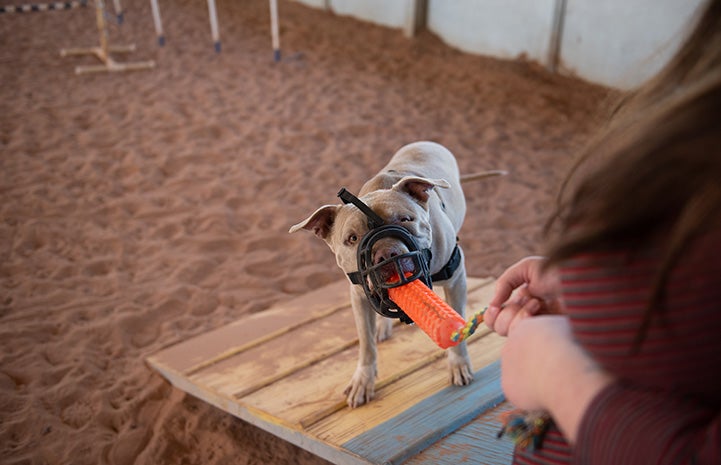
Finding a special solution for an anxious dog
Charm started life in a loving home, but when the family could no longer take care of her, she was surrendered to a shelter. She was full of energy and wanted to play all the time, so she would sometimes jump up on people and grab at their clothes for attention. That’s not an uncommon behavior for many dogs, but with each passing day at the shelter, Charm’s frustration grew, and her behavior caused potential adopters to pass on her.
[This dog with behavior challenges may not be easy, but he's totally worth it]
By the time Charm came to Best Friends Animal Sanctuary, she’d begun fixating on things she wanted to grab. Anything would do: a fence or a broom or a pipe connected to the sink. She had even hurt herself trying to grab these objects. If she couldn’t grab whatever she was fixated on, she would redirect that energy onto whatever — or whoever — was closest. Not only was Charm anxious and frustrated most of the time, it was a challenge to be around her unbridled energy. The hope was that, with more space available to her at the Sanctuary, plus the special care and enrichment she so desperately needed, she could be happy and feel good again.
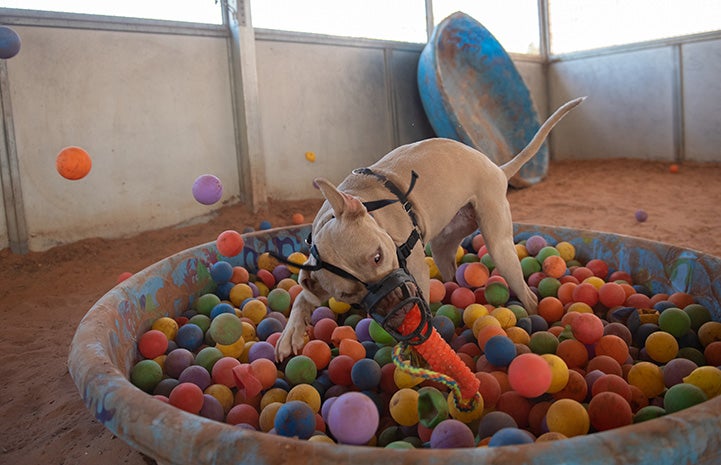
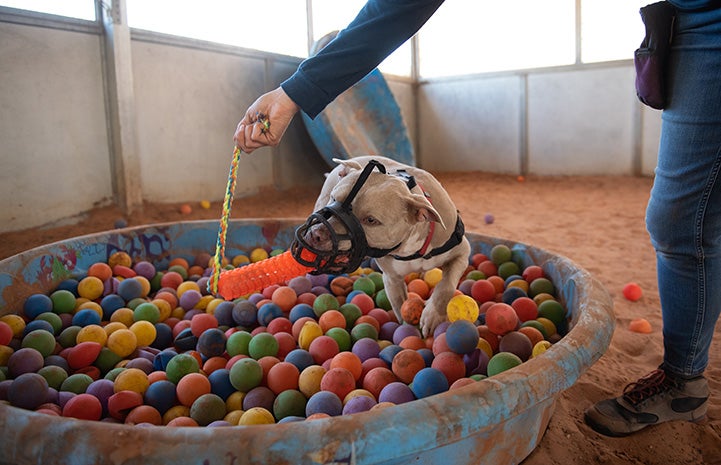
Just like a person with anxiety, Charm started taking medicine to help get some of that nervous edge off and put her into a place where her caregivers could start working with her. At first, it took three people to bring her on walks, and they had to carry several toys with them along the way.
“It was basically just a juggling act with toys,” says Davalynn Edmond, one of Charm’s caregivers. “As soon as she dropped a toy, we’d have to throw another.” If she didn’t have another toy tossed for her fast enough, she’d start jumping and grabbing at people. When she did have a toy in her mouth, she went full speed ahead on her walks. It wasn’t an enjoyable time for anyone.
Determined to make walks and other interactions safer and more comfortable for everyone involved, Davalynn decided to try training Charm to wear a muzzle. But the normal training method didn’t work: using yummy treats to get a dog to put her nose into the muzzle on her own. Charm is most into toys, not treats, and she tried to grab the muzzle and run off with it.
[Muzzle training helps a dog overcome reactivity]
“I would just lie in bed at night and think, OK, what can I do?” Davalynn recalls. She decided to figure out how to let Charm have a toy in her mouth while wearing the muzzle. The toy would have to be the right shape and size, so she experimented. “Charm had an obsession with these raccoon squeaky toys,” she says, “so I cut one in half, but it didn’t work very well. Then I ordered three different types of toys, and the pickle is the one that worked the best. It fit nicely through the muzzle, and she could squeak it while holding onto it through the muzzle.”
The toy-and-muzzle combo worked like a charm (no pun intended). Charm’s body language changed almost immediately. She went from tense to loosened up and her tail started wagging. It was a sign that she was relaxing and starting to feel better about things. And, with the rope attached to the end of the toy, her caregivers finally discovered Charm’s favorite game: tug.
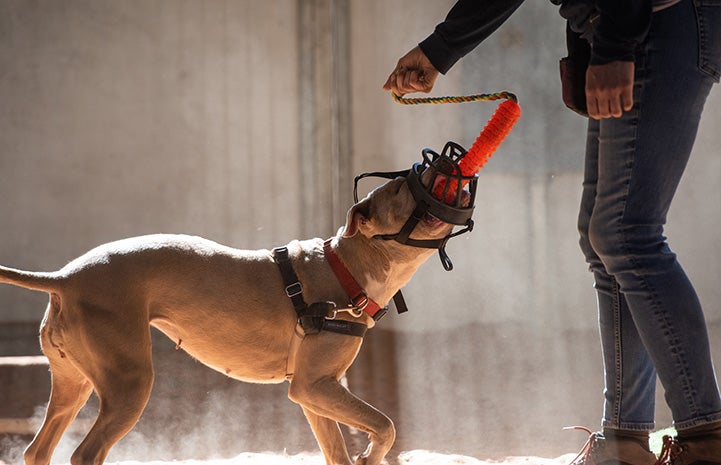
Playing tug with heartstrings
Getting Charm ready for a walk still involves a little bit of toy juggling. A low-value toy (one that she’s played with before and doesn’t squeak anymore) is offered for her to hold while she comes out of her yard. Then she sees the toy in the muzzle, sitting in a stand attached to a nearby tree, and she swaps over to that one. After that, it’s just a matter of clipping the muzzle in place. And it only takes one person to walk her now.
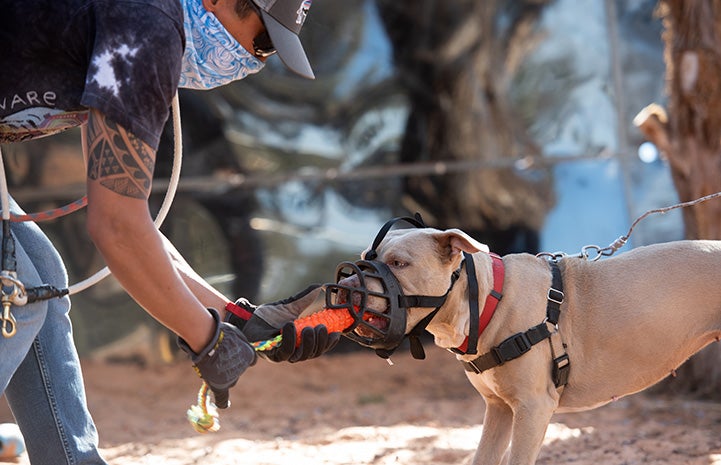
Instead of charging ahead on her walks and needing constant toy swaps, Charm takes her walks at a more leisurely pace, alternating between shaking her toy around and looking for someone to play with. “She’s super wiggly,” Davalynn says, “and she goes up to people to toss the rope to initiate play.”
[Muzzle training for scared and reactive dogs]
Everyone is a potential playmate: Charm will trot right up to anyone who’s paying attention and offer up her toy’s rope. Be ready to brace yourself and hold on tight if you agree to play, though, because Charm is one strong dog, and she is very excited to play.
She gets introduced to tour groups and enjoys a good scratch on the back when she’s not playing. She’s also going on big group walks with other dogs and making new friends. Caregivers are even starting to take Charm for outings around the Sanctuary, and they’re very interested to see how she feels about playing in the creek.
With her toy and muzzle, Charm is able to do all sorts of things she couldn’t do when she first arrived at the Sanctuary. “She’s so much happier,” says Davalynn. “This has already opened up her life drastically from what she had before.”
And they’re not done yet. The hope is that in the future, when Charm is ready, the muzzle won’t be necessary anymore, and caregivers can start working with her on more fun activities, like agility training. But for now, this not-so-scary tool is helping Charm get back to what’s really important — living her happiest life.
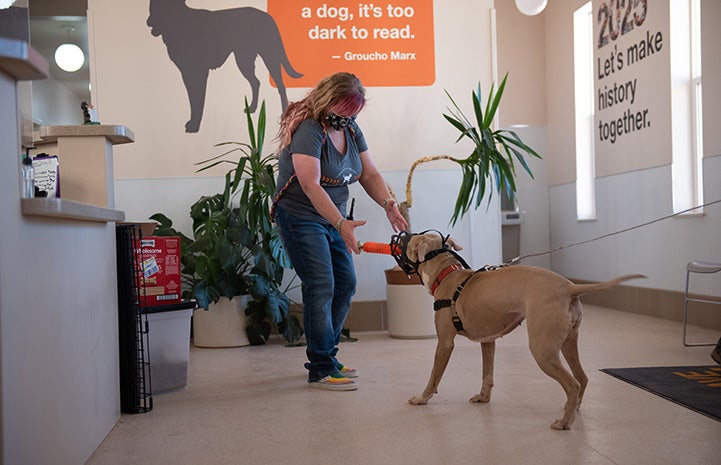
Help more pets like Charm
By joining Best Friends, you can help pets like Charm on their way to their future homes.
Read more:
How one of the least adoptable dogs finally found her people
Big, brave steps for one scared dog
Photos by Molly Wald